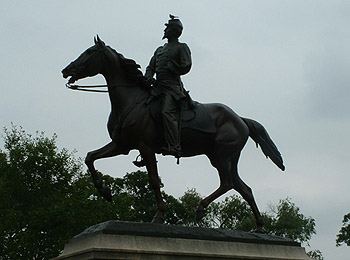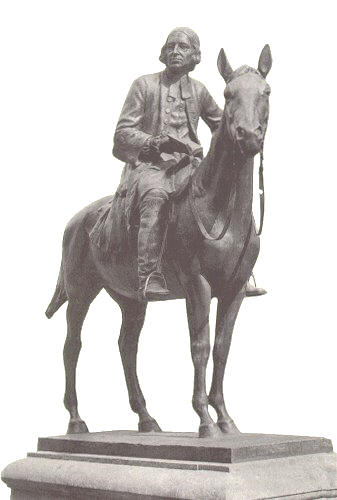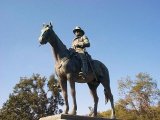
The Oakland Museum of California remembers the seismic catastrophe that rocked the Bay Area 100 years ago with Aftershock! Voices from the 1906 Earthquake and Fire, April 1–August 13, 2006. The 4,000-square-foot exhibition, with more than 250 artifacts and photographs, is the largest in California dedicated to the centennial of the earthshaking events of April 18, 1906.
Aftershock! focuses on the earthquake’s impact on the people living in the Bay Area a century ago. The 7.8-magnitude quake cut a swath of destruction from Santa Rosa to San Jose, displacing 200,000 people in San Francisco alone. The quake and three-day fire wiped out three-fifths of the city’s housing, as well as its municipal buildings and landmarks. Overnight, the financial capital of the West was in ruins. Areas founded on swamps and landfill were the hardest hit. An estimated 3,000 people perished in the fire and quake, some in cheap lodgings that collapsed as they slept.
The exhibition recounts how individuals withstood and rebounded from the calamitous 1906 events. It goes beyond the familiar images and statistics to tell the stories of a cross section of Bay Area citizens, including Dennis Sullivan, the fire chief whose death in the quake contributed to the unfocused and ineffective fire-fighting efforts; Flora Allen, a survivor and longtime participant in the annual commemoration at Lotta’s Fountain, who died recently at age 100-plus; the Quan family, who sponsored “paper sons”—male immigrants without legal documentation—after the quake destroyed citizenship records; and the renowned Spanish dancer La Estrellita, who performed in the Panama Pacific International Exhibition, a ten-month celebration of the rebirth of San Francisco; among many others
Visitors to Aftershock! can experience a simulated earthquake via a “shake-table” under the floor of a re-created Victorian room that rolls and pitches. A documentary of digitally enhanced photographs and archival film footage helps visualize the impact of the temblor, which caused damage estimated at 500 million in 1906 dollars.
The exhibition includes one of the original tents erected as temporary shelter for the newly homeless. The fourteen-by-twelve-foot canvas structure features images from the tent cities that sprang up in the earthquake’s aftermath.
Private and government relief began arriving by April 19. Los Angeles sent provisions, medicine, and volunteers. Boston and other U.S. cities sent aid, and China provided relief specifically to Chinese San Franciscans. Relief came by ferry, ship, car, and train.
Aftershock! documents how San Francisco tried to downplay the severity of the disaster and protect its commercial future. The real estate board met a week after the earthquake and passed a resolution that the phrase “the great earthquake” should no longer be used; it would be known instead as “the great fire.” Thousands of men were quickly hired to clear the rubble and begin reconstruction. Rebuilding the city was both a physical and a marketing endeavor.
By 1909 San Francisco was ready to reclaim its metropolitan status. It hosted the Portolá Festival, to mark the 140-year anniversary of Don Gaspar de Portolá’s discovery of the Bay and celebrate the city’s recovery. Six years later the city was host to the Panama Pacific International Exposition, in what is now known as the Marina and the Palace of Fine Arts. The Exposition was ostensibly held to mark the completion of the Panama Canal and serve as the 1915 World’s Fair. It drew 18 million visitors and, with the Portolá Festival, publicly moved the city’s reputation beyond the earthquake era and into the future.
The Aftershock! exhibition also covers contemporary life in earthquake country, Californians embrace of “quake culture,” memories and photographs of the 1989 Loma Prieta quake, and current seismologic technology.
Visitors to Aftershock! can experience a simulated earthquake via a “shake-table” under the floor of a re-created Victorian room that rolls and pitches. A documentary of digitally enhanced photographs and archival film footage helps visualize the impact of the temblor, which caused damage estimated at 500 million in 1906 dollars.
The exhibition includes one of the original tents erected as temporary shelter for the newly homeless. The fourteen-by-twelve-foot canvas structure features images from the tent cities that sprang up in the earthquake’s aftermath.
Private and government relief began arriving by April 19. Los Angeles sent provisions, medicine, and volunteers. Boston and other U.S. cities sent aid, and China provided relief specifically to Chinese San Franciscans. Relief came by ferry, ship, car, and train.
Aftershock! documents how San Francisco tried to downplay the severity of the disaster and protect its commercial future. The real estate board met a week after the earthquake and passed a resolution that the phrase “the great earthquake” should no longer be used; it would be known instead as “the great fire.” Thousands of men were quickly hired to clear the rubble and begin reconstruction. Rebuilding the city was both a physical and a marketing endeavor.
By 1909 San Francisco was ready to reclaim its metropolitan status. It hosted the Portolá Festival, to mark the 140-year anniversary of Don Gaspar de Portolá’s discovery of the Bay and celebrate the city’s recovery. Six years later the city was host to the Panama Pacific International Exposition, in what is now known as the Marina and the Palace of Fine Arts. The Exposition was ostensibly held to mark the completion of the Panama Canal and serve as the 1915 World’s Fair. It drew 18 million visitors and, with the Portolá Festival, publicly moved the city’s reputation beyond the earthquake era and into the future.
The Aftershock! exhibition also covers contemporary life in earthquake country, Californians embrace of “quake culture,” memories and photographs of the 1989 Loma Prieta quake, and current seismologic technology.








